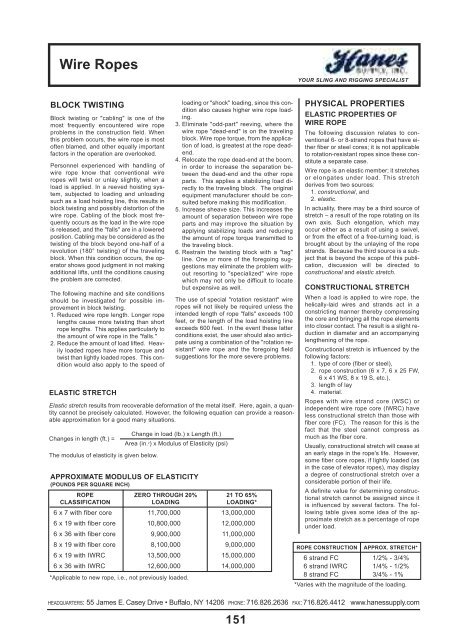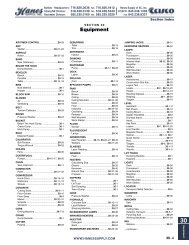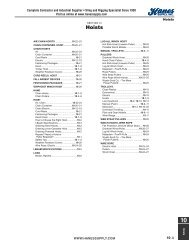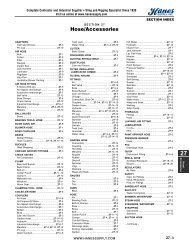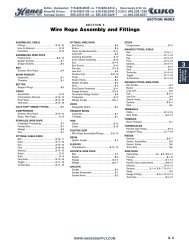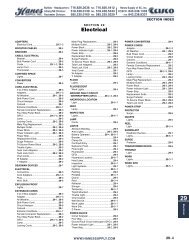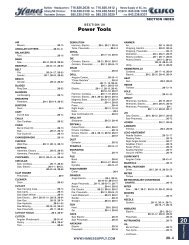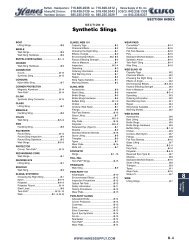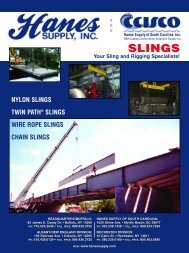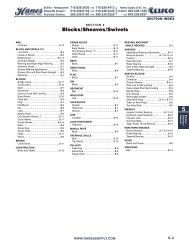YOUR SLING AND RIGGING SPECIALISTbasic lift eng<strong>in</strong>eer<strong>in</strong>geffect of anGlesVarious sl<strong>in</strong>g manufacturers refer <strong>in</strong> theirspecification tables to leg angles of <strong>sl<strong>in</strong>gs</strong>dur<strong>in</strong>g lifts – s<strong>in</strong>ce these angles have a directrelationship to lift<strong>in</strong>g capability of asl<strong>in</strong>g. Regardless of how the sl<strong>in</strong>g anglemay be stated, or the method used to computestress <strong>in</strong> a sl<strong>in</strong>g leg, the sl<strong>in</strong>g is thesame. Capacity does not change – butstresses on sl<strong>in</strong>g legs change with rigg<strong>in</strong>gangles.Much misunderstand<strong>in</strong>g results becausethe carry<strong>in</strong>g capacity of a sl<strong>in</strong>g leg is reducedby the rigg<strong>in</strong>g angle. What happensis that the operator is lift<strong>in</strong>g the loadstraight up (vertical) while the legs arepull<strong>in</strong>g at an angle, thereby caus<strong>in</strong>g a disadvantage.For quick figur<strong>in</strong>g <strong>in</strong> the shop, a 60-degreeleg angle causes a loss <strong>in</strong> lift<strong>in</strong>g capacityof 15%... a 45-degree angle reduces capacityby 30%... and a 30-degree angle,50%. This rule of thumb is not 100% accurate,but is easy to remember and slightlyon the safe side.It is always good practice, with<strong>in</strong> limits, tokeep the sl<strong>in</strong>g leg angle as large as possible.The length and width of the load sl<strong>in</strong>glength, and available headroom are determ<strong>in</strong><strong>in</strong>gfactors <strong>in</strong> this sl<strong>in</strong>g angle.It is neither economical nor good practice toexceed a 45-degree sl<strong>in</strong>g leg angle.Angles less than 45 degrees not only buildup tension <strong>in</strong> the sl<strong>in</strong>g legs out of all proportionto the weight of the load, they also createa much greater "<strong>in</strong>-pull" on the ends ofthe load. This produces eccentrically loadedcolumn effect, as an eng<strong>in</strong>eer would describeit – mean<strong>in</strong>g simply that long, slenderobjects have a tendency to buckle. Anglesless than 45 degrees <strong>in</strong>dicate some thoughtshould be given to the use of a lift<strong>in</strong>g beamor other device <strong>in</strong> connection with the lift.Study<strong>in</strong>g typical sl<strong>in</strong>g charts readily revealsthat lift<strong>in</strong>g capacities on <strong>sl<strong>in</strong>gs</strong> are mislead<strong>in</strong>gunless the sl<strong>in</strong>g angle is stated. Thesame sl<strong>in</strong>g that will handle 10 tons at an 85-degree leg angle will only handle 5 tons ifthis angle is decreased to 30 degrees.GooD slInG PRactIceRegardless of what type of sl<strong>in</strong>g may be employed,there are accepted good work<strong>in</strong>grules which will help <strong>in</strong>crease useful sl<strong>in</strong>g life– as well as improve safety. These <strong>in</strong>clude:1. Use the proper sl<strong>in</strong>g for the lift. WhetherTw<strong>in</strong>-Path, Web, Cha<strong>in</strong>, or Wire Rope, theproper sl<strong>in</strong>g is the one with the best comb<strong>in</strong>ationof work and handl<strong>in</strong>g feature – ofthe proper length and rated capacity forthe situation.2. Start and stop slowly. Crane hooksshould be raised slowly until the sl<strong>in</strong>g becomestaut and the load is suspended.Lift<strong>in</strong>g or lower<strong>in</strong>g speed should be <strong>in</strong>creasedor decreased gradually. Suddenstarts or stops place heavier loads on asl<strong>in</strong>g – comparable to jamm<strong>in</strong>g thebrakes on a speed<strong>in</strong>g automobile. A ruleof thumb: Shock loads can double thestress on a sl<strong>in</strong>g.3. If possible, set the load on blocks.Pull<strong>in</strong>g a sl<strong>in</strong>g from under a load causesabrasion and "curl<strong>in</strong>g" – mak<strong>in</strong>g the sl<strong>in</strong>gharder to handle on the next lift, while reduc<strong>in</strong>gstrength through loss of metal.4. Sharp corners cut <strong>sl<strong>in</strong>gs</strong>. Use protectorarcs, Cornermax and Synthetic ArmorWear Pads between sharp corners andthe sl<strong>in</strong>g body.5. Store <strong>in</strong> a dry room. Moisture is a naturalenemy of wire rope – as are acidfumes and other caustic gases.6. Avoid handl<strong>in</strong>g hot material or objects <strong>in</strong>direct contact with the sl<strong>in</strong>g. Strengthgoes down as temperature goes up!7. Dropp<strong>in</strong>g cast<strong>in</strong>g, tools or heavy objectson <strong>sl<strong>in</strong>gs</strong>, or runn<strong>in</strong>g over them withtrucks, can cause damage. Always hang<strong>sl<strong>in</strong>gs</strong> when not <strong>in</strong> use.8. Use hooks properly. "Po<strong>in</strong>t load<strong>in</strong>g" reduceshook capacity. Pull should bestraight <strong>in</strong> the l<strong>in</strong>e of lift.selectInG a slInGThe follow<strong>in</strong>g is presented as a guide onlyto help <strong>in</strong> selection of a sl<strong>in</strong>g for a lift.1. Determ<strong>in</strong>e the Load: The weight of theload must be known. This is always thestart<strong>in</strong>g po<strong>in</strong>t.2. Decide the Hitch: Shape and bulk of theload must be accommodated as well asweight. Determ<strong>in</strong>e whether a straight attachmentat some po<strong>in</strong>t on the load, achoker around the load, or some form ofbasket hitch will best control the loaddur<strong>in</strong>g the lift.3. Adequacy of Lift<strong>in</strong>g Device: The lift<strong>in</strong>gdevice must have adequate capacity formak<strong>in</strong>g the lift, and provide any maneuverabilityrequired once the load ishoisted.4. Room to Lift: Make certa<strong>in</strong> the lift<strong>in</strong>g devicehas sufficient headroom to raise theload to the height required. Headroomwill affect the length of sl<strong>in</strong>g.5. Length of Sl<strong>in</strong>g: By apply<strong>in</strong>g your decisionon the type of hitch to knowledge ofthe headroom offered by the lift<strong>in</strong>g device,the length of sl<strong>in</strong>g can be calculated.6. Use Rated Capacity Chart: Always double-checkthat the sl<strong>in</strong>g type and capacityyou choose, when rigged at the angle determ<strong>in</strong>edby the length of the sl<strong>in</strong>g, or thespecific type of hitch, will handle the load.Attach<strong>in</strong>g the sl<strong>in</strong>g and complet<strong>in</strong>g the liftshould be an orderly procedure without "surprises"when these steps have been followed.Two further precautions should benoted, however.First, plan to protect both load and sl<strong>in</strong>g fromdamage at sharp corners, etc. Cornermaxand Synthetic Armor Wear Pads should beprovided at the lift site. A protective padshould be used anytime a sl<strong>in</strong>g passesaround a sharp corner.Last – by no means unimportant by be<strong>in</strong>glast – every sl<strong>in</strong>g should be visually exam<strong>in</strong>edfrom end to end BEFORE EVERY LIFT.It must always be kept <strong>in</strong> m<strong>in</strong>d that the manufacturer'sRated Capacity applies only to anew sl<strong>in</strong>g <strong>in</strong> "unused" condition. A <strong>sl<strong>in</strong>gs</strong>hould be carefully exam<strong>in</strong>ed to determ<strong>in</strong>ethat it is <strong>in</strong> as nearly new condition as practicablebefore each lift.There are specific standards on the use andcare of <strong>sl<strong>in</strong>gs</strong> <strong>in</strong> <strong>in</strong>dustries such as shipp<strong>in</strong>gand construction, and these provide someguidance for sl<strong>in</strong>g <strong>in</strong>spectors. Consensusstandards published as ANSI B30.9 are particularlyhelpful.ANSI Standard B30.9 specifies that a wirerope sl<strong>in</strong>g should be removed form serviceany time any of the follow<strong>in</strong>g conditions aredetected:1. Ten randomly distributed broken wires <strong>in</strong>one rope lay, or five broken wires <strong>in</strong> onestrand <strong>in</strong> one rope lay.2. K<strong>in</strong>k<strong>in</strong>g, crush<strong>in</strong>g, bird cag<strong>in</strong>g or anyother damage result<strong>in</strong>g <strong>in</strong> distortion ofthe wire rope structure.3. Evidence of heat damage.4. End attachments that are cracked, deformed,or worn.5. Hooks that have been opened more than15% of the normal throat open<strong>in</strong>g measuredat the narrowest po<strong>in</strong>t, or twistedmore than 10 degrees from the plane ofthe unbent hook.6. Corrosion of the rope or end attachments.It is apparent from the forego<strong>in</strong>g that <strong>in</strong>spectionof a wire rope sl<strong>in</strong>g to meet theseremoval criteria requires more than a casualunderstand<strong>in</strong>g of wire rope design andmanufacture, and the responsibility fordaily <strong>in</strong>spections must be <strong>in</strong> the hands oftra<strong>in</strong>ed personnel.Most of the forego<strong>in</strong>g applies equally to anytype of sl<strong>in</strong>g and careful <strong>in</strong>spection by atra<strong>in</strong>ed <strong>in</strong>spector is necessary for safe sl<strong>in</strong>guse. If you require tra<strong>in</strong><strong>in</strong>g for any type ofsl<strong>in</strong>g <strong>in</strong>spection, contact <strong>Hanes</strong> <strong>Supply</strong> formore <strong>in</strong>formation.HEADQUARTERS: 55 James E. Casey Drive • Buffalo, NY 14206 PHONE: 716.826.2636 FAX: 716.826.4412 www.hanessupply.com150
Wire RopesYOUR SLING AND RIGGING SPECIALISTblock tWIstInGBlock twist<strong>in</strong>g or "cabl<strong>in</strong>g" is one of themost frequently encountered wire ropeproblems <strong>in</strong> the construction field. Whenthis problem occurs, the wire rope is mostoften blamed, and other equally importantfactors <strong>in</strong> the operation are overlooked.Personnel experienced with handl<strong>in</strong>g ofwire rope know that conventional wireropes will twist or unlay slightly, when aload is applied. In a reeved hoist<strong>in</strong>g system,subjected to load<strong>in</strong>g and unload<strong>in</strong>gsuch as a load hoist<strong>in</strong>g l<strong>in</strong>e, this results <strong>in</strong>block twist<strong>in</strong>g and possibly distortion of thewire rope. Cabl<strong>in</strong>g of the block most frequentlyoccurs as the load <strong>in</strong> the wire ropeis released, and the "falls" are <strong>in</strong> a loweredposition. Cabl<strong>in</strong>g may be considered as thetwist<strong>in</strong>g of the block beyond one-half of arevolution (180° twist<strong>in</strong>g) of the travel<strong>in</strong>gblock. When this condition occurs, the operatorshows good judgment <strong>in</strong> not mak<strong>in</strong>gadditional lifts, until the conditions caus<strong>in</strong>gthe problem are corrected.The follow<strong>in</strong>g mach<strong>in</strong>e and site conditionsshould be <strong>in</strong>vestigated for possible improvement<strong>in</strong> block twist<strong>in</strong>g.1. Reduced wire rope length. Longer ropelengths cause more twist<strong>in</strong>g than shortrope lengths. This applies particularly tothe amount of wire rope <strong>in</strong> the "falls."2. Reduce the amount of load lifted. Heavilyloaded ropes have more torque andtwist than lightly loaded ropes. This conditionwould also apply to the speed ofload<strong>in</strong>g or "shock" load<strong>in</strong>g, s<strong>in</strong>ce this conditionalso causes higher wire rope load<strong>in</strong>g.3. Elim<strong>in</strong>ate "odd-part" reev<strong>in</strong>g, where thewire rope "dead-end" is on the travel<strong>in</strong>gblock. Wire rope torque, from the applicationof load, is greatest at the rope deadend.4. Relocate the rope dead-end at the boom,<strong>in</strong> order to <strong>in</strong>crease the separation betweenthe dead-end and the other ropeparts. This applies a stabiliz<strong>in</strong>g load directlyto the travel<strong>in</strong>g block. The orig<strong>in</strong>alequipment manufacturer should be consultedbefore mak<strong>in</strong>g this modification.5. <strong>Inc</strong>rease sheave size. This <strong>in</strong>creases theamount of separation between wire ropeparts and may improve the situation byapply<strong>in</strong>g stabiliz<strong>in</strong>g loads and reduc<strong>in</strong>gthe amount of rope torque transmitted tothe travel<strong>in</strong>g block.6. Restra<strong>in</strong> the twist<strong>in</strong>g block with a "tag"l<strong>in</strong>e. One or more of the forego<strong>in</strong>g suggestionsmay elim<strong>in</strong>ate the problem withoutresort<strong>in</strong>g to "specialized" wire ropewhich may not only be difficult to locatebut expensive as well.The use of special "rotation resistant" wireropes will not likely be required unless the<strong>in</strong>tended length of rope "falls" exceeds 100feet, or the length of the load hoist<strong>in</strong>g l<strong>in</strong>eexceeds 600 feet. In the event these latterconditions exist, the user should also anticipateus<strong>in</strong>g a comb<strong>in</strong>ation of the "rotation resistant"wire rope and the forego<strong>in</strong>g fieldsuggestions for the more severe problems.elastIc stRetcHElastic stretch results from recoverable deformation of the metal itself. Here, aga<strong>in</strong>, a quantitycannot be precisely calculated. However, the follow<strong>in</strong>g equation can provide a reasonableapproximation for a good many situations.Change <strong>in</strong> load (lb.) x Length (ft.)Changes <strong>in</strong> length (ft.) =Area (<strong>in</strong>. 2 ) x Modulus of Elasticity (psi)The modulus of elasticity is given below.aPPRoXIMate MoDUlUs of elastIcItY(PoUnDs PeR sQUaRe <strong>Inc</strong>H)RoPe zeRo tHRoUGH 20% 21 to 65%classIfIcatIon loaDInG loaDInG*6 x 7 with fiber core 11,700,000 13,000,0006 x 19 with fiber core 10,800,000 12,000,0006 x 36 with fiber core 9,900,000 11,000,0008 x 19 with fiber core 8,100,000 9,000,0006 x 19 with IWRC 13,500,000 15,000,0006 x 36 with IWRC 12,600,000 14,000,000*Applicable to new rope, i.e., not previously loaded.HEADQUARTERS: 55 James E. Casey Drive • Buffalo, NY 14206 PHONE: 716.826.2636 FAX: 716.826.4412 www.hanessupply.com151PHYsIcal PRoPeRtIeselastIc PRoPeRtIes ofWIRe RoPeThe follow<strong>in</strong>g discussion relates to conventional6- or 8-strand ropes that have eitherfiber or steel cores; it is not applicableto rotation-resistant ropes s<strong>in</strong>ce these constitutea separate case.Wire rope is an elastic member; it stretchesor elongates under load. This stretchderives from two sources:1. constructional, and2. elastic.In actuality, there may be a third source ofstretch – a result of the rope rotat<strong>in</strong>g on itsown axis. Such elongation, which mayoccur either as a result of us<strong>in</strong>g a swivel,or from the effect of a free-turn<strong>in</strong>g load, isbrought about by the unlay<strong>in</strong>g of the ropestrands. Because the third source is a subjectthat is beyond the scope of this publication,discussion will be directed toconstructional and elastic stretch.constRUctIonal stRetcHWhen a load is applied to wire rope, thehelically-laid wires and strands act <strong>in</strong> aconstrict<strong>in</strong>g manner thereby compress<strong>in</strong>gthe core and br<strong>in</strong>g<strong>in</strong>g all the rope elements<strong>in</strong>to closer contact. The result is a slight reduction<strong>in</strong> diameter and an accompany<strong>in</strong>glengthen<strong>in</strong>g of the rope.Constructional stretch is <strong>in</strong>fluenced by thefollow<strong>in</strong>g factors:1. type of core (fiber or steel),2. rope construction (6 x 7, 6 x 25 FW,6 x 41 WS, 8 x 19 S, etc.),3. length of lay4. material.Ropes with wire strand core (WSC) or<strong>in</strong>dependent wire rope core (IWRC) haveless constructional stretch than those withfiber core (FC). The reason for this is thefact that the steel cannot compress asmuch as the fiber core.Usually, constructional stretch will cease atan early stage <strong>in</strong> the rope's life. However,some fiber core ropes, if lightly loaded (as<strong>in</strong> the case of elevator ropes), may displaya degree of constructional stretch over aconsiderable portion of their life.A def<strong>in</strong>ite value for determ<strong>in</strong><strong>in</strong>g constructionalstretch cannot be assigned s<strong>in</strong>ce itis <strong>in</strong>fluenced by several factors. The follow<strong>in</strong>gtable gives some idea of the approximatestretch as a percentage of ropeunder load.RoPe constRUctIon aPPRoX. stRetcH*6 strand FC 1/2% - 3/4%6 strand IWRC 1/4% - 1/2%8 strand FC 3/4% - 1%*Varies with the magnitude of the load<strong>in</strong>g.


